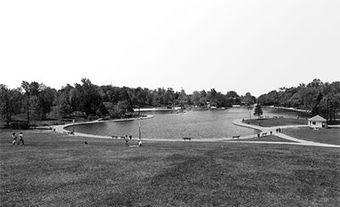Howard Burlingham Dunington-Grubb
Howard Burlingham Dunington-Grubb, landscape-architect (b Howard Grubb at York, England 30 April 1881; d at Toronto 26 February 1965). Often called the father of landscape architecture in Canada, Grubb earned a Bachelor of Science in Agriculture at Cornell University, Ithaca, New York (1904-08), and returned to England to create a job for himself in the office of landscape architect Thomas Mawson.In 1911 Howard Grubb married Lorrie Alfreda Dunington (see Lorrie DUNINGTON-GRUBB), an English landscape architect, adopting the surname Dunington-Grubb. They emigrated to Canada and opened an office in Toronto as H.B. & L.A. Dunington-Grubb, Landscape Architects. They advertised as "Consultants on all matters relating to Park and Garden Design, Real Estate and Suburban Development, Civic Art and Town Planning."
Their designs for subdivisions and garden suburbs, and the limitations of local ornamental plant resources, led them to start a plant nursery, which became, in 1914, Sheridan Nurseries. Howard Dunington-Grubb remained president of Sheridan Nurseries until his death in 1965.
The Dunington-Grubb office in Toronto produced hundreds of designs and masterplans over the years. Approximately two-thirds of the work was private residential gardens for wealthy clients. The rest covered an extremely wide range of business and government projects, including town planning and civic beautification. The best known projects were Gage Park in Hamilton, Ontario (1919-27), McMaster University Entrance Park (late 1920s), the Oakes Garden Theatre and Rainbow Bridge gardens at Niagara Falls, Ontario (1935-44), and University Avenue in Toronto, Ontario (1955-57).
The Dunington-Grubbs were sociable and very active in Toronto associations and clubs. They collaborated with, and actively promoted, other members of the arts community, such as J.E.H. MACDONALD and Arthur LISMER of The GROUP OF SEVEN, and the sculptors Frances LORING and Florence WYLE.
Howard was described by contemporaries as a "witty Englishman as tall as a Lombardy poplar." He was noted for his love of parties and theatricals, and for his sense of humour. His love of the theatrical was a key to both his character and his sense of design.
Although Dunington-Grubb was contemporary with the Modern movement, he designed in the older Beaux Arts tradition, emphasizing architectural influence on the landscape, to provide a controlled, ornamental backdrop to human use. He described his designs as "a world of fantasy, of make-believe, where decorative nature under the control of art provides both pleasure and rest." As a designer he was neither innovative nor particularly imaginative, but he was very good at tastefully amalgamating eclectic design elements.
Dunington-Grubb's real importance lies in the amount and variety of work that he accomplished and in his enthusiastic participation in, and promotion of, all facets of the profession. He wrote and lectured extensively. He was a special lecturer on landscape design for the architecture faculty at University of Toronto, where he pressed for the expansion of landscape architectural facilities and faculty. In 1934 he was one of the nine founding members of the Canadian Society of Landscape Architects and Town Planners (later becoming the CSLA), serving as president in 1934-35 and 1944-45.
He promoted the public's interest in and knowledge of design and ornamental horticulture through his activities and through the creation of the Dunington-Grubb Foundation. He received numerous awards and honours, including the Ontario Association of Architects (OAA) Allied Arts Medal and the Royal Architectural Institute of Canada (RAIC) Medal in 1954, and was made a Fellow of the CSLA in 1964.
Howard Dunington-Grubb exemplified the trends during this century-the change from private to public design, from design for estate gardens to "City Beautification" and the garden suburb, civic planning and the design of public open spaces. The creation of a nursery with a landscape contracting department heralded the appearance of design/build firms; the founding of the CSLA and his connection with the University of Toronto catalyzed the coming of age of LANDSCAPE ARCHITECTURE as a profession in Canada.

 Share on Facebook
Share on Facebook Share on X
Share on X Share by Email
Share by Email Share on Google Classroom
Share on Google Classroom


